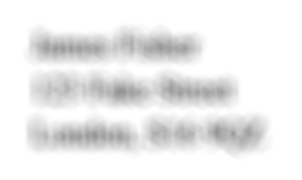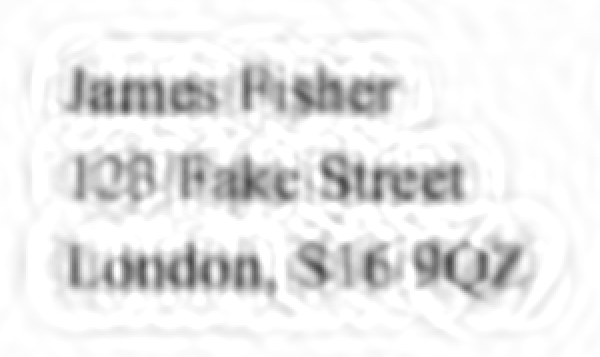When in doubt, don’t blur it out
Yesterday,
The Guardian published an article about a victim,
with an photo of a letter that had been sent to them.
To preserve the privacy of the victim,
the address on the letter had been blurred.
However, I was able to completely recover the address,
complete with the superscript “th” in the street number!
The Guardian doxxed the victim they were writing about.
Blurring is often used to redact sensitive content.
There’s apparently even a phrase, “if in doubt, blur it out”.
But, counterintuitively, blur can be completely inverted to recover the original image!
I won’t show you The Guardian’s example;
instead, here’s an example I created:
You see the original, then a blurred version, then a version recovered from this.
I used a tool called SmartDeblur,
and the author, Vladimir Yuzhikov, has
a great blog post on how it works.
But it’s complicated, so below I look at a simpler model for how deblur can work.
Consider a blur function that works on one-dimensional images.
Each pixel b[i] in the output blurred image is generated by
taking the average of three pixels in the source image:
the corresponding pixel s[i] in the source,
and its two nearest neighbors s[i-1] and s[i+1].
This is a one-dimensional equivalent of a “bokeh” or lens blur,
which averages all the pixels in a circle.
This is the blur type that The Guardian used.
To deal with the edges,
we say that out-of-bounds pixels in the source are white.
Given the blurred output from this function,
can we recover the original?
Yes, if only we make a guess at the border of the source image.
Let’s work from the left-hand side of the image.
We know s[-1] is white, because it’s out of bounds.
Let’s assume s[0] is white; this is our border guess.
Then we can recover s[1] from b[0].
We march left to right to recover the rest,
using s[i] = 3*b[i-1] - s[i-1] - s[i-2].
This model generalizes to any size blur.
We just have to guess more border,
e.g. if each blurred pixel comes from n=7 input pixels,
we must guess at a 3-pixel border.
Here’s the general algorithm in JavaScript:
function deblur(n, borderGuess, blurred) {
const m = (n-1)/2;
const out = [];
for (let i = 0; i < m; i++) out[i] = borderGuess[i];
for (let i = m; i < blurred.length; i++) {
out[i] = n*blurred[i-m];
for (let j = (i-n)+1; j < i; j++) {
out[i] -= (
j < 0 ? 1 :
j < borderGuess.length ? borderGuess[j] :
out[j]
);
}
}
return out;
}
The SmartDeblur tool is designed for real-world, arbitrary photos.
But we can probably recover a much better image
if we know that the source is text!
Usually, blurred text is given as part of a larger unblurred image,
from which we can make very strong assumptions about the blurred source.
For instance, we can be confident that the border of the source is white.
We can assume the source is black and white, rather than greyscale.
In the extreme, we could assume that the text is 12-point Times New Roman,
and recover the source text by generating characters that minimize error.
A demo of this would be a fun future blogpost ...
Similar posts
More by Jim
What does the dot do in JavaScript?
foo.bar, foo.bar(), or foo.bar = baz - what do they mean? A deep dive into prototypical inheritance and getters/setters. 2020-11-01
Smear phishing: a new Android vulnerability
Trick Android to display an SMS as coming from any contact. Convincing phishing vuln, but still unpatched. 2020-08-06
A probabilistic pub quiz for nerds
A “true or false” quiz where you respond with your confidence level, and the optimal strategy is to report your true belief. 2020-04-26
Time is running out to catch COVID-19
Simulation shows it’s rational to deliberately infect yourself with COVID-19 early on to get treatment, but after healthcare capacity is exceeded, it’s better to avoid infection. Includes interactive parameters and visualizations. 2020-03-14
The inception bar: a new phishing method
A new phishing technique that displays a fake URL bar in Chrome for mobile. A key innovation is the “scroll jail” that traps the user in a fake browser. 2019-04-27
The hacker hype cycle
I got started with simple web development, but because enamored with increasingly esoteric programming concepts, leading to a “trough of hipster technologies” before returning to more productive work. 2019-03-23
Project C-43: the lost origins of asymmetric crypto
Bob invents asymmetric cryptography by playing loud white noise to obscure Alice’s message, which he can cancel out but an eavesdropper cannot. This idea, published in 1944 by Walter Koenig Jr., is the forgotten origin of asymmetric crypto. 2019-02-16
How Hacker News stays interesting
Hacker News buried my post on conspiracy theories in my family due to overheated discussion, not censorship. Moderation keeps the site focused on interesting technical content. 2019-01-26
My parents are Flat-Earthers
For decades, my parents have been working up to Flat-Earther beliefs. From Egyptology to Jehovah’s Witnesses to theories that human built the Moon billions of years in the future. Surprisingly, it doesn’t affect their successful lives very much. For me, it’s a fun family pastime. 2019-01-20
The dots do matter: how to scam a Gmail user
Gmail’s “dots don’t matter” feature lets scammers create an account on, say, Netflix, with your email address but different dots. Results in convincing phishing emails. 2018-04-07
The sorry state of OpenSSL usability
OpenSSL’s inadequate documentation, confusing key formats, and deprecated interfaces make it difficult to use, despite its importance. 2017-12-02
I hate telephones
I hate telephones. Some rational reasons: lack of authentication, no spam filtering, forced synchronous communication. But also just a visceral fear. 2017-11-08
The Three Ts of Time, Thought and Typing: measuring cost on the web
Businesses often tout “free” services, but the real costs come in terms of time, thought, and typing required from users. Reducing these “Three Ts” is key to improving sign-up flows and increasing conversions. 2017-10-26
Granddad died today
Granddad died. The unspoken practice of death-by-dehydration in the NHS. The Liverpool Care Pathway. Assisted dying in the UK. The importance of planning in end-of-life care. 2017-05-19
How do I call a program in C, setting up standard pipes?
A C function to create a new process, set up its standard input/output/error pipes, and return a struct containing the process ID and pipe file descriptors. 2017-02-17
Your syntax highlighter is wrong
Syntax highlighters make value judgments about code. Most highlighters judge that comments are cruft, and try to hide them. Most diff viewers judge that code deletions are bad. 2014-05-11
Want to build a fantastic product using LLMs? I work at
Granola where we're building the future IDE for knowledge work. Come and work with us!
Read more or
get in touch! This page copyright James Fisher 2020. Content is not associated with my employer. Found an error? Edit this page.



 Granola
Granola